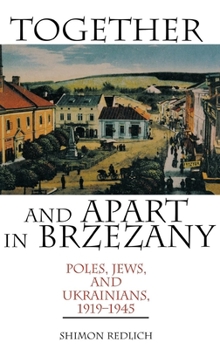Together and Apart in Brzezany: Poles, Jews, and Ukrainians, 1919-1945
". . . by reconstructing the history/experience of Brzezany in Jewish, Ukrainian, and Polish memories Redlich] has produced a beautiful parallel narrative of a world that was lost three times over. . . . a truly wonderful achievement." --Jan T. Gross, author of Neighbors
Shimon Redlich draws on the historical record, his own childhood memories, and interviews with Poles, Jews, and Ukrainians who lived in the small eastern Polish town of Brzezany to construct this account of the changing relationships among the town's three ethnic groups before, during, and after World War II. He details the history of Brzezany from the prewar decades (when it was part of independent Poland and members of the three communities remember living relatively amicably "together and apart"), through the tensions of Soviet rule, the trauma of the Nazi occupation, and the recapture of the town by the Red Army in 1945. Historical and contemporary photographs of Brzezany and its inhabitants add immediacy to this fascinating excursion into history brought to life, from differing perspectives, by those who lived through it.





